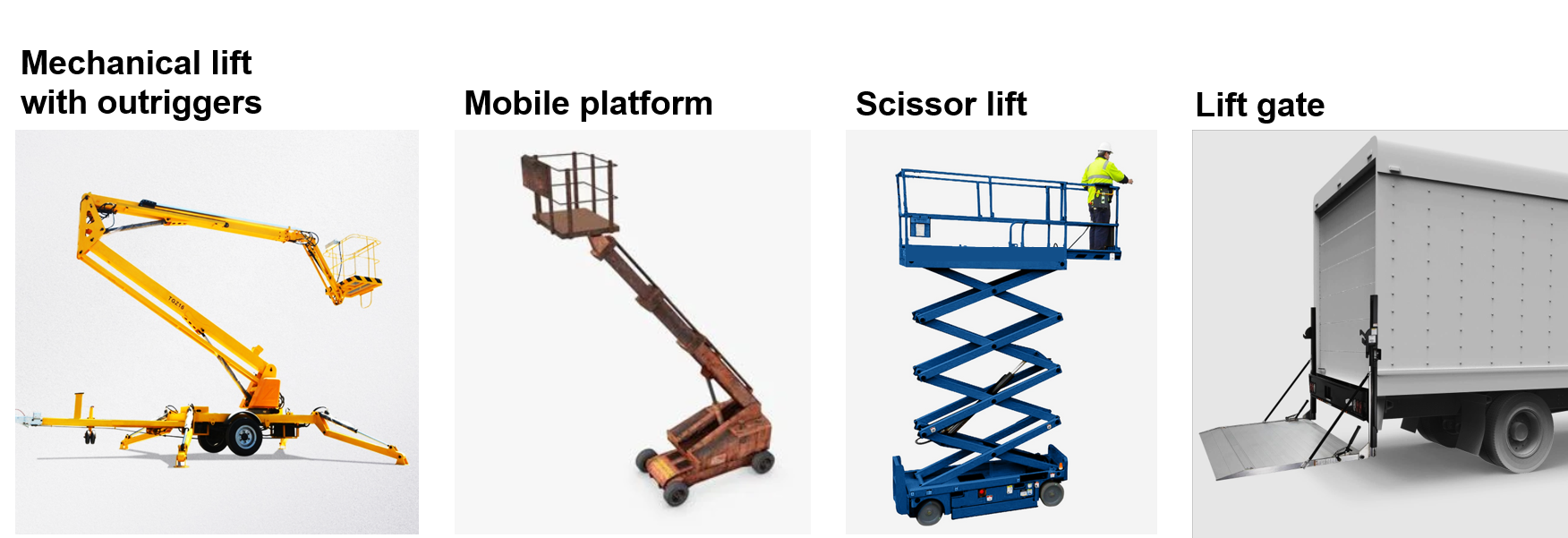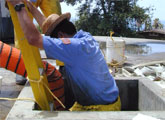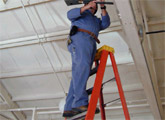Ladder and Lift Safety
Last Updated: November 4, 2024 2:28:20 PM PST
Give feedback
Learn about the importance of training and safety precautions for using ladders and other lift equipment.
Get required safety training on equipment to be used.
Employees: Check with your supervisor about scheduling training before you use ladders, lifts, truck lift gates and/or perform high-elevation work. Training must be specific to the equipment the employee will operate.
Supervisors must provide basic operational and safety training for work involving:
- Ladders, mechanical lifts, and mobile platforms ("cherry pickers")
- High elevations requiring fall protection (such as rooftops or scaffolding)
- Activity adjacent to floor openings or pits (e.g., theater scenery pits)
Employees must also review the owner/operations manual for the specific equipment being utilized and are aware of the location of the manual for future reference.
Pictured here are examples of some types of equipment:

Available Training Courses
For trucks, see lift gate training:
Ladders:
Forklift:
Plan ahead to minimize possible problems and risks before you get started.
- Use the right equipment. Select and use the correct ladder or lift for the job.
- Examine your work area for possible electrical hazards.
- Be alert for overhead power lines obscured by tree branches or other visual obstacles.
- Never use a metal ladder around live electricity. Use a ladder with nonconductive side rails if there is any possibility the ladder could contact exposed energized parts.
- Consider the work location. Keep ladders and lifts away from doorways or walkways, unless they can be protected by barriers, a locking door, or a guard.
- Consider how to prevent falls. Fall protection planning is important because trips, slips, and falls are among the most frequent types of accidents. Elevated falls, even from a few feet, can result in severe injuries such as broken bones, internal injuries, permanent disability, and even death.
Practice basic ladder safety.
- Inspect ladders before each use:
- Use the Ladder Inspection form (PDF) to survey your equipment.
- Check the weight rating on your ladder. Do not subject the ladder to a load greater than its rated capacity.
- Make sure there are nonslip safety feet on each ladder foot and secure the ladder evenly against a solid support.
- Check for cracks, rust, broken rungs and rails, and oily or greasy rungs.
- Tag damaged ladders as "defective" and remove them from the workplace.
- Make sure the ladder is stable:
- Secure the ladder evenly against a solid support.
- Secure the base of a long ladder to the ground if possible, and tie the top to the upper landing surface. If you are going to use the ladder for access to an upper landing surface, secure it against sideways movement at the top or have another worker hold it in place during use.
- When you are climbing onto a roof, your ladder should extend at least 3 feet higher than the roof.
- Remember the 4–to–1 rule: For every 4 feet of rise, the base of the ladder should be 1 foot away from the object that the top of the ladder is resting against. For example, if the ladder touches the wall 16 feet above the ground, the base of the ladder should be 4 feet from the wall.
- Practice safe climbing, standing, and reaching from a ladder:
- Climb and descend the ladder carefully, facing it and using both hands.
- Maintain 3-point contact when climbing up and down a ladder or working from it. 3-point contact means 1 hand and 2 feet or 2 hands and 1 foot on the ladder at all times. The potential for a fall is significantly reduced if 3-point contact is maintained at all times.
- Do not stand on the topcap or the step below the topcap of a stepladder.
- Never push or pull anything sideways while on a ladder. This puts a side load on the ladder that can cause it to tip out from under you.
- Lean into the ladder while working, and keep your hips centered between the side rails.
- Overreaching is probably the most common cause of falls from ladders. Follow these precautions:
- Select a ladder tall enough for the job. This will prevent you from reaching too far forward or upward, which could cause you to lose your balance.
- Do not overreach from a ladder, or lean too far to one side. Work as far as you can reach comfortably and safely, then climb down and move the ladder to a new position.
- Use care with tools and heavy loads:
- Use a tool belt or hand line to carry materials.
- Never carry heavy or bulky loads up a ladder. Climb up yourself first, and then pull the material up with a rope.
- Do not leave tools or materials on top of ladders. If they fall, you or someone else could be hurt.

Rooftop ladder and hatch

Using a ladder for work overhead
Resources
- American Ladder Institute
- Ladder Inspection form (PDF), Werner Co.
- Operating Rules for Industrial Trucks (Forklifts) (PDF)
- Portal Ladder Safety eTools, from Cal/OSHA
- Aerial Lifts & Falls in the Workplace from CDC
For more information, contact EH&S General Safety, (858) 534-7513.